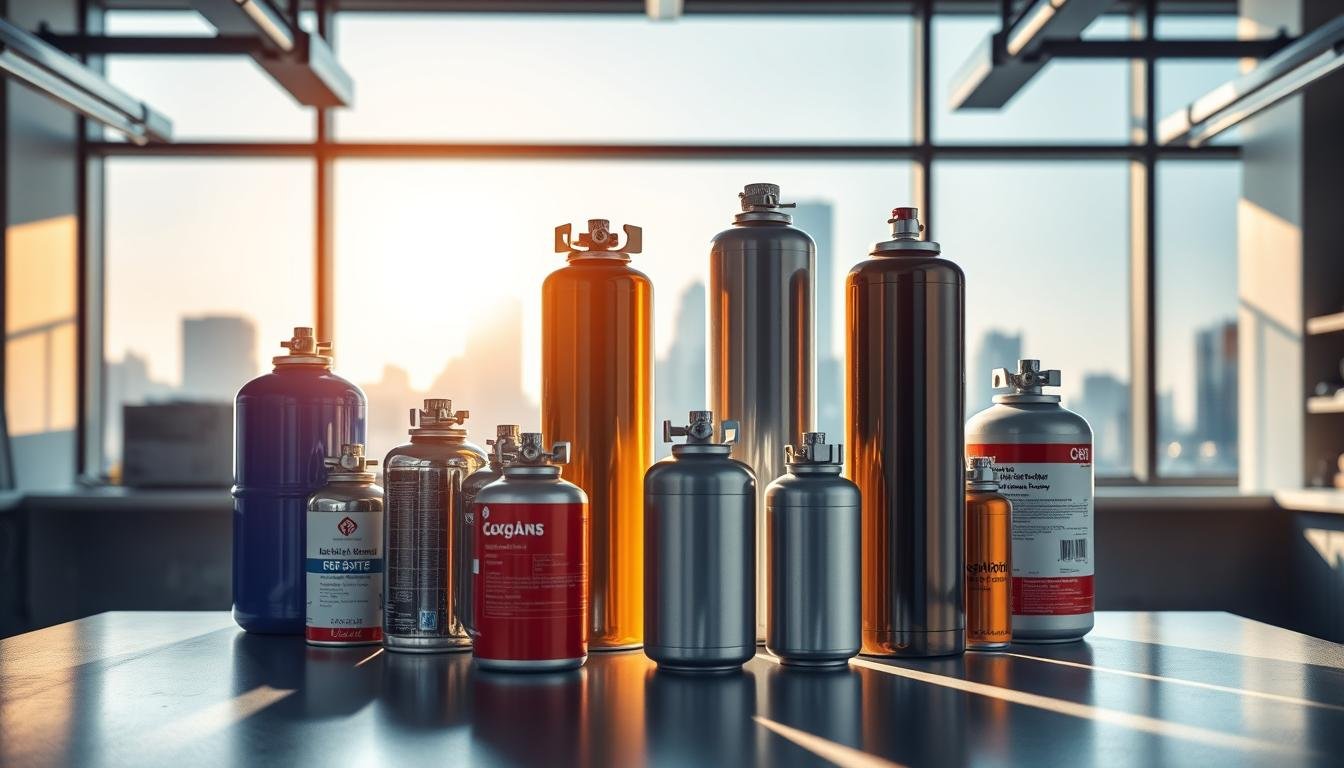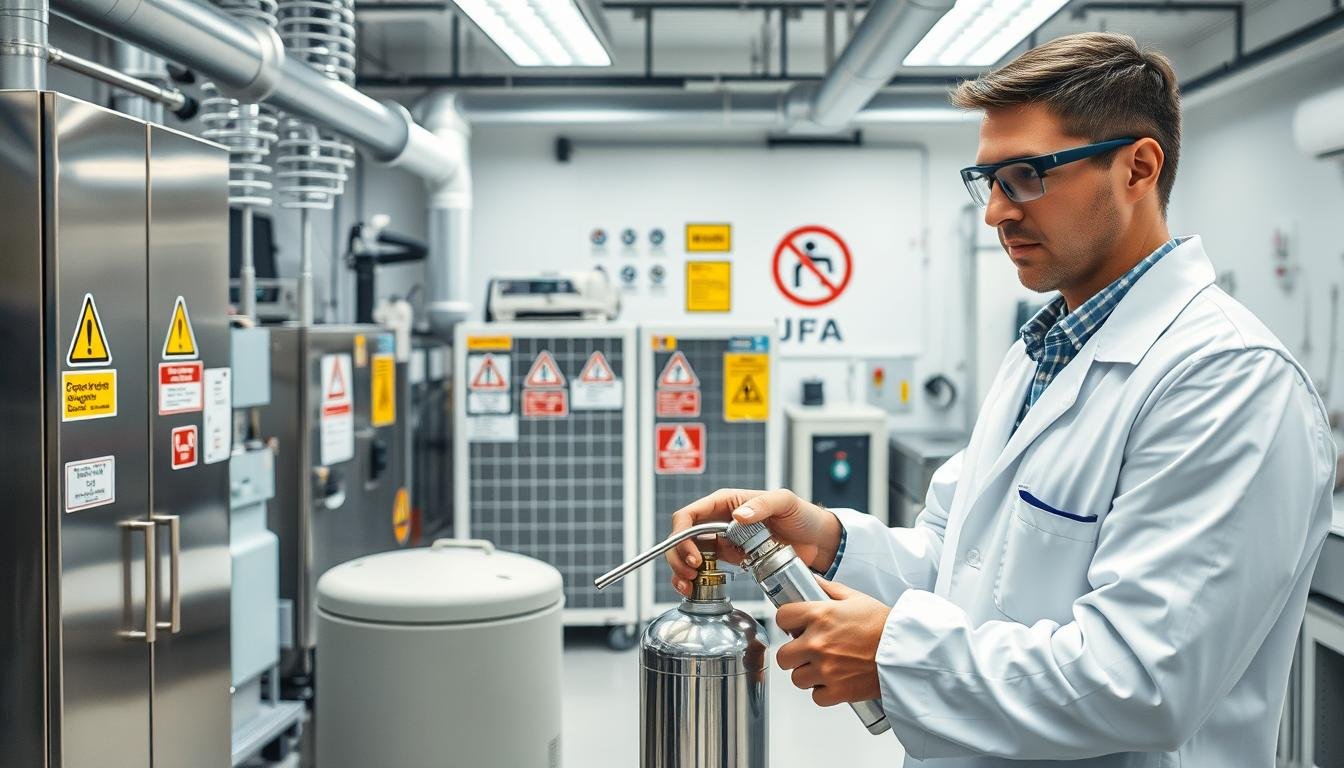Blog
Best Refrigerant 2025: Your Ultimate Comparison Guide

As we head into 2025, picking the right refrigerant for HVAC systems is key. Refrigerants are vital for the efficiency, safety, and environmental impact of heating and cooling systems. With so many options, comparing refrigerants can feel overwhelming. Our guide aims to make this easier. It provides a detailed comparison of the most effective refrigerants for 2025.
Choosing the best refrigerant is essential. It helps improve system performance, cuts down on environmental harm, and meets regulatory standards.
Key Takeaways
- Understanding the role of refrigerants in HVAC systems.
- Key factors to consider when comparing refrigerants.
- Overview of the most promising refrigerants for 2025.
- Environmental and performance implications of different refrigerants.
- Guidance on selecting the most suitable refrigerant for your needs.
Understanding Refrigerants in2025
The HVAC industry is always changing, thanks to new rules and tech. Knowing about refrigerants is key in 2025. These substances change from liquid to gas as they take in heat. This makes them vital for heating, ventilation, and air conditioning systems.
What Are Refrigerants and How Do They Work?
Refrigerants move heat from one place to another. They are key for cooling and heating. They go through a closed-loop system, touching parts like compressors and condensers.
The refrigerant you choose affects the system’s energy efficiency, safety, and how well it works.
Why Choosing the Right Refrigerant Matters
Picking the right refrigerant is important. It affects the environment and how well the system works. Things like Global Warming Potential (GWP) and Ozone Depletion Potential (ODP) matter a lot. The right one also makes sure the system follows the rules and works better.
The Evolution of Refrigerants: From CFCs to Modern Solutions
The journey of refrigerants from chlorofluorocarbons (CFCs) to modern alternatives shows human ingenuity and care for the environment. The refrigeration industry has changed a lot. This is thanks to new refrigerant technology and changes in laws.
Historical Development of Refrigerants
At first, refrigerants were toxic and flammable. Then, CFCs came along because they were safe and didn’t catch fire. But, we found out CFCs hurt the ozone layer. This led to the Montreal Protocol in 1987, a global plan to stop using harmful substances.
This change led to looking for new refrigerants. Hydrofluorocarbons (HFCs) were seen as safer. But, they were found to have a big impact on global warming.
Current Regulatory Landscape in the United States
In the U.S., the Environmental Protection Agency (EPA) controls refrigerants under the Clean Air Act. New rules are coming to reduce HFCs because of their warming effect. They want to use refrigerants that are better for the planet.
Types of Refrigerants Available in2025
In 2025, we see a big change in refrigerants. We need cooler solutions that are better for the planet. Now, we have many options, each with its own good and bad points.
HFCs (Hydrofluorocarbons)
HFCs are used a lot because they don’t harm the ozone layer. But, they do release a lot of greenhouse gases. Examples include R-410A and R-404A. Even though they’re used now, they might not be around for long because of new rules.
HFOs (Hydrofluoroolefins)
HFOs are newer and better for the environment than HFCs. They don’t release as much greenhouse gas. R-1234yf is a commonly used HFO. They’re a good choice for replacing HFCs in many places.
Natural Refrigerants
Natural refrigerants like CO2, ammonia, and hydrocarbons are becoming popular. They don’t harm the environment much. CO2 is used in commercial refrigeration, and ammonia in big industrial places. Hydrocarbons are used in some special cases.
Blends and Alternatives
Refrigerant blends mix different refrigerants to get the best results. They aim to be safe, work well, and be good for the planet. For example, R-448A is a blend used as a replacement for R-404A. The search for new blends and options is ongoing.
Environmental Impact Assessment of Modern Refrigerants
As we look ahead to 2025, it’s key to understand the environmental effects of modern refrigerants. The move to greener refrigerants is big, thanks to worries about global warming and ozone depletion.
Global Warming Potentia (GWP) Explained
Global Warming Potentia (GWP) shows how much heat a gas traps in the air over time, compared to CO2. Modern refrigerants vary in GWP, with some being much better than others. For example, hydrofluoroolefins (HFOs) have a much lower GWP than traditional HFCs.
Ozone Depletion Potentia (ODP) Considerations
Ozone Depletion Potentia (ODP) is also important for judging refrigerant impact. It measures how much a substance can harm the ozone layer. Moving from CFCs to lower or zero ODP alternatives has helped protect the ozone. Many new refrigerants, like HFOs and natural ones, have zero or very low ODP.
Environmental Regulations and Compliance in 2025
In 2025, rules on refrigerants will keep getting stricter to lessen their environmental harm. Following these rules means knowing the GWP and ODP of used refrigerants. Companies and users must stick to standards for using refrigerants with less harm, pushing for greener cooling options.
Performance Factors to Consider When Choosing Refrigerants
When picking a refrigerant, several key factors are important. The right one can greatly improve your HVAC system’s efficiency, reliability, and eco-friendliness.
Energy Efficiency Ratings
Energy efficiency is key because it affects your costs and the environment. Choose refrigerants with high ratings to save on energy and bills. The U.S. Department of Energy says using efficient refrigerants can cut energy bills by up to 30%.
Cooling Capacity and System Compatibility
The refrigerant’s cooling power must fit your HVAC system’s needs. The wrong one can lower performance and wear out parts. Make sure it works well with your system’s design and materials to avoid damage.
Operating Pressure and Temperature Ranges
Refrigerants need to work within certain pressure and temperature ranges. Working outside these can cause system failures, safety risks, and environmental harm. Always check the manufacturer’s guidelines for the right operating conditions.
By looking at these factors, you can pick a refrigerant that boosts your system’s performance, saves energy, and is better for the planet.
Step-by-Step Guide to Selecting the Best Refrigerant2025
The world of refrigerant technology is changing fast. A step-by-step guide can help you pick the best refrigerant for 2025. Choosing the right one is key for both the planet and your system’s efficiency.

Step 1: Assess Your System Requirements
First, know what your system needs. Think about cooling capacity, operating temperature, and pressure ranges. This helps you find refrigerants that fit your system.
Step 2: Evaluate Environmental Factors
When picking a refrigerant, think about the planet. Look at the Global Warming and Ozone Depletion Potentials. Choose ones with low GWP and zero ODP to protect the environment.
Step 3: Consider Performance Needs
The refrigerant’s performance affects your cooling system’s efficiency. Look at energy efficiency ratings and how well it works in your system. High-performance refrigerants save energy and make your system more reliable.
Step 4: Analyze Cost Implications
Lastly, think about the costs. Consider the upfront cost and long-term expenses. Cost-effective refrigerants might cost more at first but save money in the long run due to better energy use.
By following these steps, you can choose the best refrigerant for 2025. We aim to help you pick one that’s good for your system and the planet.
Top Refrigerant Brands and Products for2025
Looking ahead to 2025, we need to focus on the best refrigerant brands and their new products. The HVAC world is always changing, with a big push for green solutions and new tech. A few big names are leading the market with their top-notch refrigerants.
Chemours Opteon Series
Chemours’ Opteon series is known for its low global warming impact and top-notch performance. It has a variety of refrigerants for different uses, from big stores’ freezers to car air conditioning. These products cool well and are kind to the planet.
Key benefits of Opteon series:
- Low GWP
- High energy efficiency
- Versatile applications
Honeywell Solstice Series
Honeywell’s Solstice series is also well-known for being eco-friendly. Solstice refrigerants are made to work great and meet green rules. They fit many HVAC needs.
Notable features of Solstice series:
- Environmentally friendly
- High-performance cooling
- Regulatory compliance
Natural Refrigerant Manufacturers
Natural refrigerant makers are becoming more popular as we move towards greener options. Companies like those making carbon dioxide (CO2), hydrocarbons, and ammonia are providing options with little to no GWP. These are being used in many places, like big stores and factories.
Some benefits of natural refrigerants include:
- Very low or zero ODP and GWP
- Abundant availability
- Cost-effective in the long term
Cost Analysis of Refrigerant Options
Understanding the costs of refrigerants is key to making smart choices. The cost of a refrigerant isn’t just the initial price. It also includes other factors that can affect your budget.
Initial Purchase Costs
The first cost you see is the price of the refrigerant. High-performance refrigerants might cost more at first. But, they can save money in the long run because they’re more efficient and last longer.
Hydrofluoroolefins (HFOs) are better for the environment and could save you money over time, even if they cost more to start.
Long-term Operational Expenses
Long-term costs are important to consider. Things like energy efficiency, how well the system works with other parts, and upkeep costs matter a lot. Refrigerants with lower global warming impact might save you money and help the planet.
Retrofit vs. Replacement Considerations
Choosing between updating your system or replacing it is a big decision. Retrofitting can save money but might not work with new refrigerants. Replacing the system costs more upfront but could save you money and meet new rules in the future.
Looking at all these factors helps us make a choice that’s good for now and later. It’s about finding a balance between cost, savings, and being kind to the environment.
Safety Considerations for Modern Refrigerants
Modern refrigerants bring new safety challenges. The move to greener options means we must be extra careful. Safety is key in this new world of refrigerants.

Toxicity Classifications
Refrigerants are sorted by how toxic they are. This is vital for safe handling. The ASHRAE Standard 34 breaks them down into different toxicity levels. Knowing these levels helps us stay safe while working with refrigerants.
- Class A: Low toxicity
- Class B: High toxicity
Flammability Ratings and Risks
Flammability is another big safety issue. Modern refrigerants vary in how flammable they are. The ASHRAE Standard 34 groups them by flammability too. For example:
- Class 1: Non-flammable
- Class 2L, 2, or 3: More flammable
Knowing these ratings helps us understand the risks. It guides us in taking the right safety steps.
Handling and Storage Best Practices
Safe handling and storage of refrigerants are essential. They prevent accidents and keep our work area safe. Here are some best practices:
- Always wear protective gear, like gloves and safety glasses.
- Make sure the area is well-ventilated when working with refrigerants.
- Keep refrigerant containers in a cool, dry spot, away from sunlight.
By sticking to these tips, we can lower the risks of working with refrigerants.
Transitioning to New Refrigerants: A Practical Guide
Switching to new refrigerants is more than just following rules. It’s about making HVAC systems better for our planet. A good plan is key to making this change smoothly.
Assessing Your Current System
First, check your HVAC system. Look at the refrigerant type, system age, and condition. This helps figure out the best new refrigerant and what changes you need to make.
Planning the Transition Process
Planning is essential for a smooth transition. You need to research new refrigerants, check if they work with your system, and think about costs. Don’t forget to train your team on how to use these new refrigerants safely.
Working with HVAC Professionals
Working with HVAC experts is critical. They know the best ways to use new refrigerants and make system changes. Together, you can avoid problems, keep systems running well, and follow all rules.
Future Trends in Refrigerant Technology
Looking ahead to 2025 and beyond, refrigerant technology is set for big changes. The push is for greener solutions and meeting new rules.
Emerging Refrigerant Technologies
New refrigerant tech is coming to tackle our environmental worries. Hydrofluoroolefins (HFOs) and natural refrigerants are leading the way. They have lower Global Warming Potentials.
Predictions for Regulatory Changes
Expect stricter rules on refrigerants from regulatory groups. We see tighter GWP limits and more checks on environmental rules. This will drive the industry towards greener choices.
Conclusion
Choosing the best refrigerant for 2025 is complex. We’ve looked at different refrigerants and their importance. We’ve seen how environmental impact, performance, and safety matter.
The move towards greener options is growing. Companies like Chemours and Honeywell are leading the way. They offer products that are efficient and kinder to the planet.
When picking a refrigerant, think about your system’s needs and the environment. Also, consider how well it will perform. This way, you can find the right refrigerant for 2025. It will meet regulations and work well for your system.
